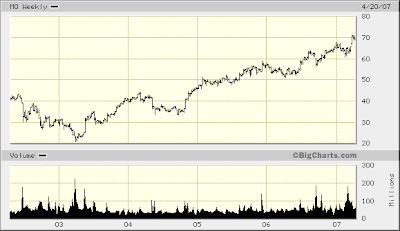- “No matter how you try and spin it, they missed the quarter, missed it. All the other items in your post (spin off of PMI, buybacks) are all old news, the street has already factored them into the price of the stock. That is why it did not even participate in this weeks action.”
I said in my interveiw with Geoff Gannon for his wonderful blog Gannon on Investing my best investing decision was buying MO in 2003 (my worst was selling USG in that same year, although my not buying CHD last year is rivaling that moronic decision). Let’s see what MO has done since then:

I am averaged in at about $29 a share. Has MO beat every quarter ‘s estimates the last 4 years? Absolutely not! But, is there anyone out there, looking at this chart who would have sold this stock, OR be disappointed had they bought it? Let also not forget the 12% dividend I got in 2003 that has continued to climb along with the stock. Had some of you been “Rich” from the email and a short term thinker, I am sure you would have sold along the way after an earnings “miss” and would be kicking yourself now.
Let’s talk about the “news already factored in” comment. To a certain extent this is true. To an extent. The “hope” of these events are in the stock, not the actual event. For proof we only need look at the recent Kraft spin off from MO. The day before the actual event (well after it was first announced in Jan.), MO traded for $85 a share. For the spin, we got Kraft shares with a monetary value at just under $22 a share. The day after the spin, MO traded for $70 a share. Given our $22 Kraft windfall that means MO had a pre-spin value (for trading purposes) of $92 but traded for only $85. Why the difference? If the announced event was fully factored in, the value of it should have been realized in the stock pre-spin, but it wasn’t.
Should the actual spin of PMI be announced, the stock will jump. It will jump again after the actual event. The same can be said of a share buy-back announcement. There is a possibility these will not happen anytime soon or ever, this is why the value of them is not fully being realized in the stock now. The buyback possibility is not being factored in at all because nobody knows how much they will buy back. 1% of the shares? 10%? More? The amount is a huge determination is what happens to the price of MO shares.
More proof that a PMI spin and buybacks are not being factored in? Look at MO’s PE. It currently stands at about 13 times earnings, well within it historical range. Were these upcoming stock boosting events being factored into the stock price currently, one would expect MO to be trading at a premium to it’s it historical PE, not at the midrange of it.
In my reply to “Rich” I stated the above albeit an abbreviated version and asked him to save my response and get back to me in a year…… let’s see if he does.








